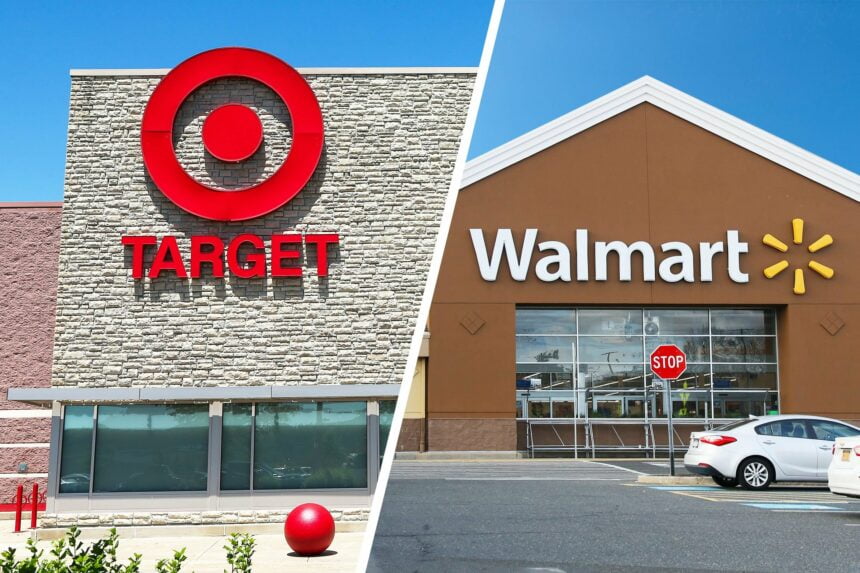This week, Walmart’s stock increased. Shares of Target decreased.
Food, apparel, household goods, and kitchen appliances are just a few of the items that the rival big-box competitors are renowned for offering. Both of their CEOs, Brian Cornell of Target and Doug McMillon of Walmart, assumed their positions in 2014.
But this week, the stores provided dramatically different outlooks that highlighted their contrasts, most notably in how much each depends on sales of groceries.
Following an 8.2% increase in U.S. same-store sales in the third quarter when fuel was excluded from the comparison, Walmart boosted its financial projection for the year on Tuesday. Target lowered their projection for the holiday quarter the next day after comparable sales increased by just 2.7%, with executives citing worsening trends in advance of the season.
Compared to Target, Walmart generates a much larger percentage of sales from groceries, which attracts customers eager to cut costs as inflation puts a strain on their budgets.
According to corporate papers, 56% of Walmart’s annual sales come from groceries, compared to 20% at Target. By revenue, Walmart is the biggest grocery store in the nation.
Although it doesn’t have the same variety, Target also provides groceries. Instead of having full-service bakeries, meat and fish counters, or delis where customers may get freshly made turkey and cheese, for instance, supermarkets only sell eggs, milk, fruits, and vegetables.
According to Neil Saunders, managing director of the retail advisory firm GlobalData, more customers are using Walmart to complete the majority of their shopping lists.
In contrast, customers frequently “top up shop” at Target, picking up a few groceries while running to purchase something else, like diapers.
Customers have had to keep replacing the food in their refrigerators even while they choose not to buy a TV or new clothing, which is keeping Walmart’s sales steady.
The phrase “daily low prices” and Walmart’s emphasis on value have come to be associated with each other. In order to make groceries and other goods more accessible, company founder Sam Walton created the business using a no-frills strategy.
The big-box shop has an advantage because of its reputation as a discounter as Americans examine their budgets more closely. Additionally, the business has exercised its capacity to use its size and scale to maintain cheap prices.
McMillon, the CEO of Walmart, frequently touts the brand as a leader in pricing and, more lately, as a fighter against inflation. The business promised to maintain the cost of Thanksgiving staples like ready-to-heat macaroni and cheese at levels from the previous year.
More households with higher incomes are becoming consumers because of the affordable prices.
According to the business, households earning above $100,000 per year have accounted for nearly 75% of its market share increases in food over the last two quarters.
With a variety of “cheap chic” goods, Target has transformed its stores into mini-malls.
It has introduced exclusive private brands like Hearth & Hand, a home decor line produced with famous home improvement team Chip & Joanna Gaines, and All in Motion, a stylish but more affordable activewear brand.
Additionally, it offers stores for well-known national brands like Ulta Beauty, Apple, and Disney. Moreover, there is a Starbucks there where customers may get a latte to sip as they shop.
Because of the selection, there are jokes about “Target runs,” where customers stop by for toothpaste but leave with much more.
According to study conducted by GlobalData prior to the epidemic, about 21% of Target’s sales are made inadvertently. The percentage is roughly 12% at Walmart.
It is harder to convince people to go on shopping sprees and make impulse purchases when there is inflation.
“People are starting to say ‘Do I actually need this?’” Saunders of GlobalData remarked. “When people do that, that affects Target more so than Walmart.”
Although clients of both stores come from a variety of socioeconomic backgrounds, Target’s typically wealthier.
According to GlobalData, the average household income of Target customers is roughly $79,000, compared to Walmart customers’ average family income of about $62,000.
Target benefited from its middle-class consumers during the pandemic as they suddenly felt wealthy thanks to stimulus packages and the money they weren’t spending on eating out, travelling, or sending their kids to summer camp.
Target’s sales increased significantly during the pandemic thanks to those customers. In the most recent full fiscal year, 2021, their yearly sales increased by nearly 36% to $106 billion from 2019.
And despite a third-quarter earnings report that disappointed Wall Street, its revenues increased 3% to $26.52 billion over the same period last year.
Target made expenditures prior to the pandemic, such as remodelling shops, introducing curbside pickup, and converting locations into fulfilment centres for online orders, which are helping to fuel the increase.
Target is now up against more competing spending demands as people resume vacationing, eating out, and commuting to work. Additionally, the business is finding it more difficult to surpass its own growth.
“It’s picked a lot of that low handing fruit,” Saunders stated. “Now even if there wasn’t this consumer crunch, it would have been much more difficult to eke out gains.”












